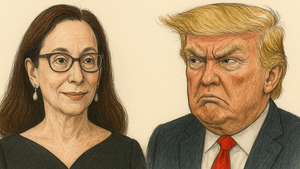The recently fired boss of the US Copyright Office, Shira Perlmutter, has sued Donald Trump, arguing that the President doesn’t have hiring and firing power over that role. She wants the courts to confirm she is, in fact, still the US Register Of Copyrights and Director of the Copyright Office, and that any decisions made by her replacement, Paul Perkins, are null and void from the off.
The Copyright Office sits within the US Library Of Congress, and is therefore part of the legislative branch of the US government, not the Trump-led executive branch. And yet, says Perlmutter’s lawsuit, earlier this month Trump “attempted to bulldoze over Congress’s role in selecting leadership within the Library Of Congress”.
First he replaced the Librarian Of Congress Carla D Hayden with Todd Blanche - the lawyer who previously represented Trump in his 2024 criminal trial and is now Deputy Attorney General in the US Department Of Justice - and then “purported to remove Shira Perlmutter” from her Copyright Office role. But Trump’s “attempts to remove Ms Perlmutter are blatantly unlawful”, the lawsuit adds.
Perlmutter’s firing came as the Copyright Office was particularly newsworthy because of its ongoing consultation on copyright and AI, which is happening at the same time Trump’s team is working on a big AI report that will include some consideration of copyright matters.
Many suspect Trump’s team will be more willing to back AI companies that claim AI training is fair use under US law, meaning they can make use of copyright protected works without seeking permission.
As Perlmutter’s lawsuit notes, the Copyright Office published its report on that fair use defence the day before she was sacked, concluding that “some uses of copyrighted works in generative AI training were likely to qualify as fair use, but some uses were likely to require licensing”.
The legal filing doesn’t explicitly allege that the publication of that report led to Perlmutter’s firing, and it seems more likely that the report was rush-released because Perlmutter anticipated her impending removal as Register Of Copyrights.
However all these political manoeuvrings at the Library Of Congress are particularly concerning for the copyright industries given all the litigation and lobbying over the copyright obligations of AI companies.
Perlmutter’s lawsuit goes into more detail about the events that preceded her sacking, expanding on the core argument for why her removal was unlawful. That begins with a discussion of the earlier removal of Hayden from the role of Librarian Of Congress.
Trump’s spokesperson said that sacking was prompted by concerns over Hayden’s DEI initiatives, including “putting inappropriate books in the library for children. Even though, as Perlmutter’s legal filing notes, the Library Of Congress is “a non-lending research library accessible only by those age sixteen and older”.
Although the Library Of Congress is part of the legislative branch of the US government, the Librarian Of Congress who runs it is appointed by the President.
However the appointment needs to be “confirmed by a vote of the Senate” in Congress. And while the President can temporarily fill roles in the executive branch of government that also require confirmation by the Senate without going through the confirmation process, that doesn’t apply to the Library Of Congress, Perlmutter argues.
Therefore Trump didn’t have the power to unilaterally appoint Blanche as the new Librarian Of Congress, which means Blanche didn’t have the power to sack Perlmutter, whether he did so on his own initiative or at the request of Trump.
All of which, the lawsuit concludes, means Perlmutter’s sacking, and her replacement by Perkins - who, like Blanche, also works in the Department Of Justice - were unlawful and should not be recognised.

